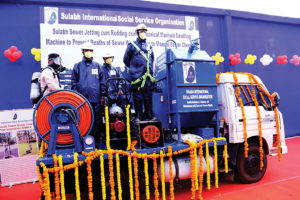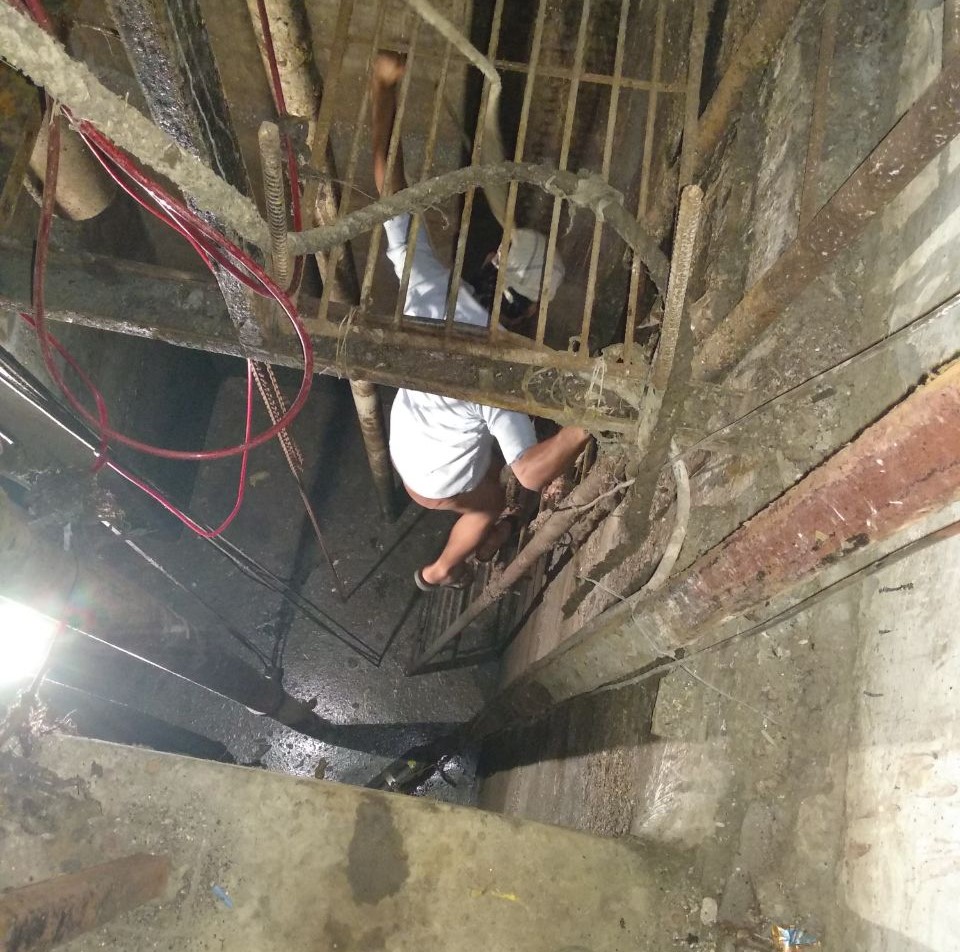The government’s decision to introduce sewer cleaning machines is a step in the right direction. But with no further development in sight, the promise is far from being honoured
In February this year, the Delhi Jal Board released a statement that read: “The board approved the deployment of specially-fabricated or tailor-made 200 sewer cleaning machines for cleaning of sewer lines in narrow streets or lanes of Delhi. After implementation of the scheme, it will be helpful in maintaining the sewer line by cleaning and maintaining through technological appliances and will eliminate the practice of manual scavenging in sewer lines. The machinery is expected to reduce the human involvement in cleaning of sewage systems to bare minimum.”
No reports have come out on any action on the ground to back up these noble intentions.
Renu Chhachhar, an official from Safai Karmchari Andolan, told Patriot that the Delhi Jal Board had invited her and some other members for a meeting with the officials of Delhi Jal Board. The December 11 meeting was about the same machines the Delhi Jal Board boasted of earlier this year.
“In the meeting, a company from Hyderabad talked about a robotic machine. On enquiring about the 200 machines, I was told that they haven’t been bought yet and might come sometime in January,” says Chhachhar.
A junior engineer of the Delhi Jal Board, who requested for anonymity, also confirmed that no such machines have come up yet. “They’ve not been cleared yet. There has been some panga (issue),” says the engineer.
It has almost been a year since the Delhi Jal Board made the promise of bringing in such machines. Patriot reached out to the PRO of Delhi Jal Board for comment, followed by the Member (Drainage) official, but we got no response.
“In a move to rehabilitate safai karamcharis and manual scavengers, the Delhi government is ready to set a benchmark making them entrepreneurs by providing loans to own sewer cleaning machines,” the government said in a statement.
Alarming numbers
According to the Safai Karmchari Andolan — an organisation and a movement that aims to eradicate manual scavenging from the country — this practice led to 11 deaths in 2018 in Delhi. Last year, 300 deaths occurred throughout the country, of which, Delhi accounted for 24 deaths. The numbers present a frightening picture but are testimony to the grim reality. Since 1993, a total of 1,760 persons have lost their lives to this evil.
Despite this, there are 77,000 sewer cleaners in the country today.
The government has given many statements on this situation. However, only one regulation seems to have been seriously implemented to redress the issue — releasing funds for providing the aggrieved families Rs 10 lakh as compensation. But compensation was paid only in 70 of the 123 cases.

In 2017, Dalberg Advisors with support of The Gates Foundation, conducted a study on sanitation workers across the country. The study analysed the issue through a worker’s, as well as an institutional perspective.
The five-month study on sanitation workers came up with some shocking numbers. As per the study, there are about 1,53,000 sewer cleaners, 18,000 septic tank cleaners and 4,17,000 drain cleaners working in India.
The study also says, “that the number of urban sanitation workers is lesser than rural workers, however, urban workers carry out the riskier jobs such as sewer cleaning and septic tank cleaning.”
Not only does it talk about the difficulties faced by these workers, but it also lists three things which make up the safety equipment kit — reusable rubber gloves, surgical masks and reflector vest.
Not a single person out of the 24 people who died in the capital, was provided any safety gear while being asked to go in the sewer or septic tank.
The National Commission of Safai Karamcharis (NCSK), a non-statutory body of the Ministry of Social Justice, relies extensively on news reports to track workers in the absence of a systematic identification system.
As per NCSK, 612 people have died since 1993 due to manual scavenging. However, the figure is questioned by many and said to be a gross underestimation of the deaths.
It is a no-brainer that manual scavenging is cast-based. Rooted deep within the caste system, most of the manual scavengers are from Dalit-sub castes —like Valmiki, Bhangi, Mehtar and Lalbegi residing in the northern parts of the country. Even the study by Dalberg Advisors says that during the 53 interviews they conducted, “96% of the workers were from these sub-castes.”
Bezwada Wilson, activist and National Convener of the Safai Karmchari Andolan, says, “I have not received a single response from the PMO. They just want to remain silent about this. That’s the attitude towards the marginalised, which is not healthy for a democracy.”
He further adds, “Delhi has 7,000 km of sewage lines. Why are they talking about 15-20 machines? You cannot have a comparison here,” says Wilson.
Wilson also says that not every death is being reported. “They say these are not sewage deaths. They’ll say it was not dirty and there were no toxic gases. You cannot reduce the number of such deaths,” he added.
As mentioned on the Safai Karmachari Andolan website, Wilson was once approached by the Employment Exchange Office for a job. He was told that he would only be given the job of a sanitation worker because of his caste.
Paul Diwakar, a Dalit activist and general secretary of National Campaign for Dalit Human Rights, says, “Some people in urban areas want to merge and to be able to do this, they have all changed their names. They also feel that they can run away from this system, once they identify themselves as the dominant caste. They do this in order to evade that kind of work.”
On the future of manual scavenging, Diwakar says that the government’s decision to introduce machines “is a step in the right direction. I think it’s a matter of time that they will bring them.”
“All these people will blame each other. Congress, if they return to power, or AAP. We have to push them and ask for a permanent solution to this” says Diwakar.
Meanwhile, a machine was launched by Sulabh International, a social service organisation. The machine injects high-pressure water into the tunnels and tanks, and then collects the waste with a mechanical bucket operated from ground level.
With this, the organisation has also unveiled a remote-control inspection camera that generates high-resolution images of the sewer system.
“We demonstrated the machine and the camera to NDMC. Even though we have not received any order, but from what we’ve been hearing, there are 80, not 200 sewer cleaning machines,” says Ajay Kumar Verma, senior advisor at Sulabh International.
Damning Data
Manual scavengers in Delhi – 438
Deaths so far in Delhi – 96
Sewer cleaners – 77,000
Deaths reported – 1,760
Dalits and women cleaners – 98%
Source: Safai Karmchari Andolan
A septic end
Two friends were forced into cleaning a septic tank, even though it was not part of their jobs. Sadly, only one could make it out alive, but he is still struggling to make ends meet
For Pradeep Sharma, 21, life was going as planned. He completed his ITI in Pump Operator-cum-Mechanic and later got a job in the posh colony of DLF Capital Greens in the Moti Nagar area of Delhi.
Working under a maintenance company called Unnati Engineering & Contractors, Sharma’s job was to look after maintenance, inspect and troubleshoot problems of the pump motor. After an initial struggle with the erratic shift system, Sharma finally settled into his work. But this did not last long. One day he was asked to do a task that exposed the malicious nature of our society.
Sharma usually played cricket with his friend Vishal and other boys in the colony’s ground on Sunday. But September 9 was different because he was called for work that day. After completing his morning shift, when he was about to leave at 2 in the afternoon, his shift in-charge told him and five other men to clean a 15-feet deep tank.
“I refused at first. But then the in-charge said that the contract was to be renewed the next day and they needed to tick it off their checklist,” says Sharma.
Sharma was reluctant to go inside, so much so that there was only one thought stuck in his head —’This is not my work. I will not clean the tank’. The person in-charge was successful in sending Sharma and Vishal inside one tank and the rest were sent inside the other tanks.
No safety equipment was provided. The tank was dark and deep, with the overhead hole as the only source of light.

“When I entered the tank, I was not scared, rather I was quite calm. I thought it’s just another tank. Since it was not my work, I decided that I will not clean the tank, but will only stay there for a while,” adds Sharma.
Suddenly he started feeling thirsty, while Vishal was already nauseous. He then decided to get out of the tank and bring some water for Vishal. “I went to the basement of the building but there was no water, so I came back,” he says.
When Sharma got back and looked inside the tank, he saw a horrifying sight — Vishal was choking because of the poisonous gas. He ran to make a call from the building’s landline. Soon, some staff members came up and pulled out Vishal.
“I was seeing my childhood friend in the worst state possible. He was drenched in sewage and I could smell the stench even from a distance of five feet,” says Sharma.
He accompanied Vishal to Bhikshu Hospital. Even though Vishal was able to talk a little and sense things, Sharma could understand that his friend was still feeling nauseous.
“He got some treatment but they told us to take him to RML (Ram Manohar Lohia) Hospital,” says Sharma. He had to return because he was asked to clean himself up. He also had to inform Vishal’s family.
“My brother was shocked when I told him about the incident, but he was relieved that nothing happened to me,” says Sharma. He rushed back to the hospital at around 6:20 pm. “But when I reached, I got to know that 10 minutes back the doctors had declared him dead,” says Sharma.
With a heavy heart he returned home. His entire family knew about what had happened, except his mother. “Her mental health has not been stable for two years now, so we decided not to tell her,” says Sharma, adding that the neighbours were told not to tell her about the incident.
For Sharma too, the days after the incident have not been easy. He keeps having frequent headaches, fatigue and is also not able to sleep properly.
“My ordeal has more to do with the loss of a friend. We were childhood friends — our schools were next to each other. We always used to play cricket together. I miss him,” says Sharma.
After this incident, Sharma quit his job at the site and doesn’t have a permanent job now. Although he tries to get work as a supervisor at weddings, the work pays about Rs 700 per day, which according to him is not sufficient for his livelihood.
His father, a driver, is the sole earner in the family. He has been following up with his employers about his provident fund, but he mostly gets the same response — the supervisor is in prison and his signatures are required. But he claims that the supervisor is no longer in prison.
One day, some policemen showed up at his home and told him that his name was on the list of people who were to receive the compensation — an amount of Rs1.2 lakh. But he says that he hasn’t received it yet.
He says that he’s still waiting for it “but I want my PF for now because I worked hard for that job,” he adds.
Today, he has no work, but plans to look for a job. However, there is a lingering fear – he does not want his job to take the course that it took last time.





